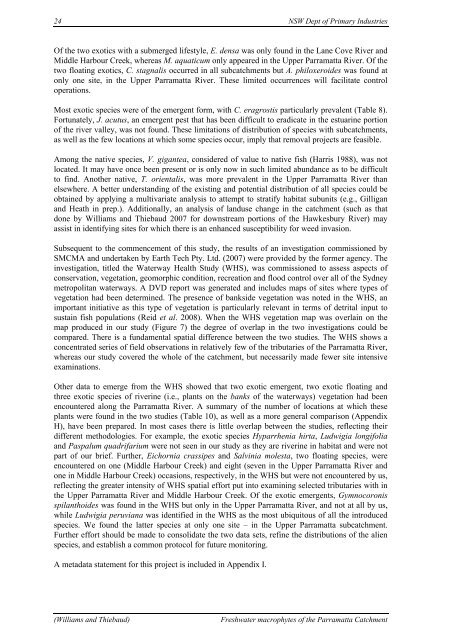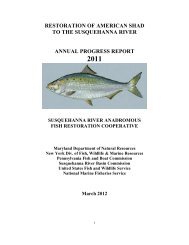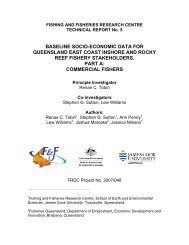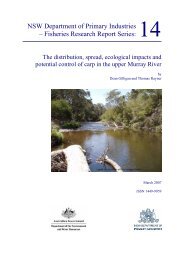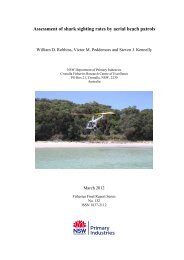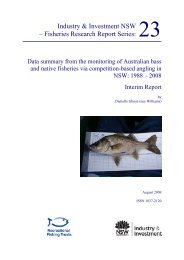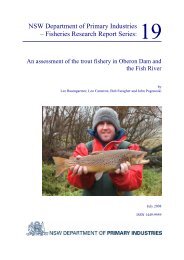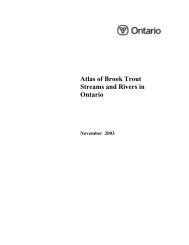The freshwater macrophytes of - Fisheries Reports
The freshwater macrophytes of - Fisheries Reports
The freshwater macrophytes of - Fisheries Reports
Create successful ePaper yourself
Turn your PDF publications into a flip-book with our unique Google optimized e-Paper software.
24 NSW Dept <strong>of</strong> Primary Industries<br />
Of the two exotics with a submerged lifestyle, E. densa was only found in the Lane Cove River and<br />
Middle Harbour Creek, whereas M. aquaticum only appeared in the Upper Parramatta River. Of the<br />
two floating exotics, C. stagnalis occurred in all subcatchments but A. philoxeroides was found at<br />
only one site, in the Upper Parramatta River. <strong>The</strong>se limited occurrences will facilitate control<br />
operations.<br />
Most exotic species were <strong>of</strong> the emergent form, with C. eragrostis particularly prevalent (Table 8).<br />
Fortunately, J. acutus, an emergent pest that has been difficult to eradicate in the estuarine portion<br />
<strong>of</strong> the river valley, was not found. <strong>The</strong>se limitations <strong>of</strong> distribution <strong>of</strong> species with subcatchments,<br />
as well as the few locations at which some species occur, imply that removal projects are feasible.<br />
Among the native species, V. gigantea, considered <strong>of</strong> value to native fish (Harris 1988), was not<br />
located. It may have once been present or is only now in such limited abundance as to be difficult<br />
to find. Another native, T. orientalis, was more prevalent in the Upper Parramatta River than<br />
elsewhere. A better understanding <strong>of</strong> the existing and potential distribution <strong>of</strong> all species could be<br />
obtained by applying a multivariate analysis to attempt to stratify habitat subunits (e.g., Gilligan<br />
and Heath in prep.). Additionally, an analysis <strong>of</strong> landuse change in the catchment (such as that<br />
done by Williams and Thiebaud 2007 for downstream portions <strong>of</strong> the Hawkesbury River) may<br />
assist in identifying sites for which there is an enhanced susceptibility for weed invasion.<br />
Subsequent to the commencement <strong>of</strong> this study, the results <strong>of</strong> an investigation commissioned by<br />
SMCMA and undertaken by Earth Tech Pty. Ltd. (2007) were provided by the former agency. <strong>The</strong><br />
investigation, titled the Waterway Health Study (WHS), was commissioned to assess aspects <strong>of</strong><br />
conservation, vegetation, geomorphic condition, recreation and flood control over all <strong>of</strong> the Sydney<br />
metropolitan waterways. A DVD report was generated and includes maps <strong>of</strong> sites where types <strong>of</strong><br />
vegetation had been determined. <strong>The</strong> presence <strong>of</strong> bankside vegetation was noted in the WHS, an<br />
important initiative as this type <strong>of</strong> vegetation is particularly relevant in terms <strong>of</strong> detrital input to<br />
sustain fish populations (Reid et al. 2008). When the WHS vegetation map was overlain on the<br />
map produced in our study (Figure 7) the degree <strong>of</strong> overlap in the two investigations could be<br />
compared. <strong>The</strong>re is a fundamental spatial difference between the two studies. <strong>The</strong> WHS shows a<br />
concentrated series <strong>of</strong> field observations in relatively few <strong>of</strong> the tributaries <strong>of</strong> the Parramatta River,<br />
whereas our study covered the whole <strong>of</strong> the catchment, but necessarily made fewer site intensive<br />
examinations.<br />
Other data to emerge from the WHS showed that two exotic emergent, two exotic floating and<br />
three exotic species <strong>of</strong> riverine (i.e., plants on the banks <strong>of</strong> the waterways) vegetation had been<br />
encountered along the Parramatta River. A summary <strong>of</strong> the number <strong>of</strong> locations at which these<br />
plants were found in the two studies (Table 10), as well as a more general comparison (Appendix<br />
H), have been prepared. In most cases there is little overlap between the studies, reflecting their<br />
different methodologies. For example, the exotic species Hyparrhenia hirta, Ludwigia longifolia<br />
and Paspalum quadrifarium were not seen in our study as they are riverine in habitat and were not<br />
part <strong>of</strong> our brief. Further, Eichornia crassipes and Salvinia molesta, two floating species, were<br />
encountered on one (Middle Harbour Creek) and eight (seven in the Upper Parramatta River and<br />
one in Middle Harbour Creek) occasions, respectively, in the WHS but were not encountered by us,<br />
reflecting the greater intensity <strong>of</strong> WHS spatial effort put into examining selected tributaries with in<br />
the Upper Parramatta River and Middle Harbour Creek. Of the exotic emergents, Gymnocoronis<br />
spilanthoides was found in the WHS but only in the Upper Parramatta River, and not at all by us,<br />
while Ludwigia peruviana was identified in the WHS as the most ubiquitous <strong>of</strong> all the introduced<br />
species. We found the latter species at only one site – in the Upper Parramatta subcatchment.<br />
Further effort should be made to consolidate the two data sets, refine the distributions <strong>of</strong> the alien<br />
species, and establish a common protocol for future monitoring.<br />
A metadata statement for this project is included in Appendix I.<br />
(Williams and Thiebaud) Freshwater <strong>macrophytes</strong> <strong>of</strong> the Parramatta Catchment


